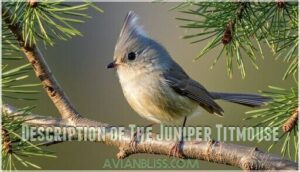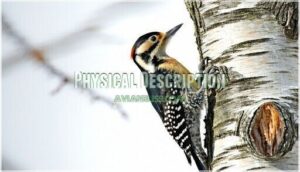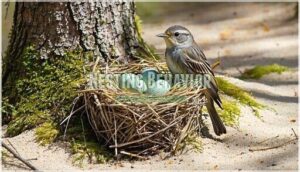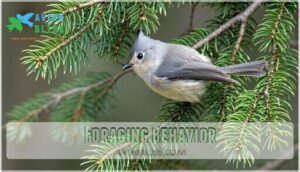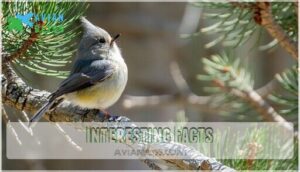This site is supported by our readers. We may earn a commission, at no cost to you, if you purchase through links.

This small gray bird sports a distinctive feisty crest and bold black eye that gives it serious personality.
They’re year-round residents who excavate their own nest holes in dead wood, unlike many songbirds.
These acrobatic foragers hang upside-down from branches, searching bark crevices for insects and seeds.
Their plain appearance masks remarkable adaptability to harsh desert conditions.
While currently stable, habitat loss from development and climate change poses growing concerns.
These scrappy survivors have fascinating social behaviors and survival strategies that reveal nature’s ingenuity in unexpected places, showcasing their ability to thrive in a challenging environment with harsh desert conditions and requiring serious personality to survive.
Table Of Contents
- Key Takeaways
- Description of The Juniper Titmouse
- Habitat and Distribution
- Physical Description
- Nesting Behavior
- Foraging Behavior
- Unique Behavioral Traits
- Conservation Status
- Interesting Facts
- Frequently Asked Questions (FAQs)
- What is the difference between a juniper titmouse & a plain titmouse?
- What family does the Juniper Titmouse belong to?
- Where do titmouse & juniper birds live?
- Where do juniper titmouse nest?
- Are juniper titmouse common in Texas?
- Are juniper and oak titmouse the same?
- What is the difference between Oak Titmouse and Juniper Titmouse?
- What do juniper titmice eat?
- Why do they call it a titmouse?
- How big is a Juniper Titmouse?
- Conclusion
Key Takeaways
- You’ll find these gray birds only in pinyon-juniper woodlands across the American Southwest, where they’re permanent residents with distinctive crests and bold black eyes.
- They’re expert cavity nesters who excavate their own holes in dead wood and display remarkable acrobatic foraging skills, hanging upside-down to search for insects and seeds.
- You’re watching nature’s desert specialists who’ve adapted brilliantly to harsh conditions through smart behaviors like seed caching and snake-like hissing defense tactics.
- Their habitat faces growing threats from development and climate change, making conservation of pinyon-juniper woodlands crucial for these scrappy survivors‘ future.
Description of The Juniper Titmouse
Among the Great Basin’s pinyon-juniper woodlands, you’ll encounter a small gray songbird that’s both charming and distinctive.
The Juniper Titmouse (Baeolophus ridgwayi) stands out with its prominent black eye and feisty tuft of feathers crowning its head.
This gray titmouse measures about 5.5 inches long, sporting grayish-brown plumage variations with paler underparts that sometimes show a subtle olive tint.
You’ll notice the bird’s crest function as a mood indicator—raised when excited or alarmed, lowered during relaxed moments.
Size comparisons place it between a Bushtit and Dark-eyed Junco, weighing just half an ounce.
The bird’s stout bill and round head create identification challenges with similar species, but vocal differences help distinguish it.
Its rapid, rolling call resembles video game sounds, making this description memorable.
The plain face lacks distinct markings except for that striking black eye that gives the bird its alert, intelligent expression.
Habitat and Distribution
You’ll find the Juniper Titmouse exclusively in western North America’s pinyon-juniper woodlands. These western birds call home a territory spanning central Oregon, northern California, Nevada, Utah, Arizona, and western Colorado.
They’re true habitat specialists, sticking to their preferred elevation preferences between 1,640 and 26,200 feet in mid-elevation woodland environments.
The Great Basin region serves as their primary stronghold, where scattered Pinyon Woodlands create perfect bird habitat. These resilient birds avoid dense forests, preferring open woodlands with sparse canopy and shrubby undergrowth.
Their range boundaries closely follow juniper distribution patterns, reflecting their dependence on these specific trees.
Climate change threatens to shift their habitat northward, potentially redrawing current range boundaries. Ecoregion Health depends on maintaining these fragmented woodland patches that support stable year-round populations throughout their territory.
Physical Description
This feathered inhabitant of western woodlands displays distinctive characteristics that make identification straightforward.
The Juniper Titmouse measures 5.75 inches with uniform gray plumage variation minimal throughout seasons. Its prominent crest function involves raising feathers when alert, creating the signature tufted silhouette. Size comparison places it between a Bushtit and Dark-eyed Junco.
Eye prominence stands out dramatically against plain facial features, while the short, thick bill shape suits its seed-cracking lifestyle. They’re commonly found in pinyon-juniper forests.
Key identification features that’ll help you spot this small bird species:
- Gray coloring with subtle lighter underparts
- Raised crest creating pointed head shape
- Beady black eye contrasting against plain face
- Compact size with stocky, rounded build
Nesting Behavior
When you’re observing Juniper Titmice during breeding season, you’ll notice their preference for secure cavity nests that offer protection from predators and harsh weather.
These resourceful birds select natural tree holes or abandoned woodpecker cavities, typically 3-20 feet above ground in mature juniper or pinyon pine trees.
Nest Placement
You’ll find Juniper Titmice selecting natural tree cavities or old woodpecker holes in juniper and pinyon pine trees for nesting.
These cavity nesters typically choose sites 6-8 feet high, though nest height ranges from 2-13 feet.
They show strong site fidelity, often reusing successful locations yearly.
Dead branches and living trunks provide ideal nest orientation and protection from predators.
To encourage nesting, consider installing boxes in late winter or spring before the breeding season.
Nest Description
Juniper Titmouse nests showcase remarkable nest construction skills.
You’ll find these cozy homes built from soft nesting materials including fine grasses, plant fibers, and animal hair.
The female creates a cuplike shape measuring 3-5 inches across, perfectly fitted to the cavity size.
Here’s what makes their nests special:
- Soft fur and feather lining for warmth
- Plant material woven into sturdy walls
- Nest dimensions adapted to tree cavities
- Moss padding for extra comfort
- Tree crevices used for seed storage nearby
These nest materials create perfect nurseries for their speckled white eggs.
To enhance the comfort, they sometimes utilize specialized nest padding.
Foraging Behavior
Why do these gray acrobats work so hard for their meals? Juniper Titmice display remarkable foraging behavior that showcases their adaptability and survival skills.
They employ acrobatic foraging techniques, hanging upside down from branches to access insects hidden in foliage and bark crevices.
Their foraging strategies include:
- Insect consumption peaks during spring and summer months
- Seed storage in tree crevices provides winter survival insurance
- Diet adaptations shift seasonally from arthropods to seeds
- Feeder visits supplement natural food sources with suet
- Cooperative foraging occurs in small family groups post-breeding
These birds demonstrate impressive versatility in juniper woodlands, combining precision with athletic prowess.
Supplementing their diet with high-energy suet cakes can be particularly helpful.
Unique Behavioral Traits
Beyond their impressive foraging behavior, these birds showcase remarkable intelligence through their Social Interactions and Adaptive Learning.
You’ll find them using Tool Use techniques, manipulating twigs to extract insects from bark crevices—a behavior that demonstrates sophisticated Problem Solving abilities.
These clever birds turn twigs into precision tools, transforming bark crevices into insect treasure troves through pure woodland ingenuity.
Their Vocal Mimicry skills are equally impressive. Bird vocalizations include over 20 distinct calls, with complex "scolding" sequences during predator encounters.
They’ll imitate other species’ calls, creating a rich soundscape throughout juniper woodlands. Their diverse communication includes alarm calls to warn of danger.
Bird behavior studies reveal their caching expertise, storing seeds in tree crevices like nature’s preppers. When threatened during nesting, females produce snake-like hissing sounds—an effective defense mechanism that catches predators off-guard.
Their territorial displays combine wing-flicking and tail-spreading with persistent dawn singing. Males mark boundaries while females join defensive efforts when nests face threats.
These bird diet specialists adapt their daily activity patterns during temperature extremes, showing remarkable resilience compared to other songbirds in similar environments.
Conservation Status
You’ll want to understand the Juniper Titmouse’s conservation status since this specialized bird faces real challenges in today’s changing landscape.
While currently listed as Least Concern globally, local populations struggle with habitat loss and climate pressures that threaten their pinyon-juniper woodland homes.
Threats to Habitat
Several serious environmental threats put your Juniper Titmouse at risk.
Pinyon-juniper woodland reduction accounts for sixty percent of nesting territory loss, while urban development fragments primary breeding grounds.
Wildfires have damaged over 90,000 acres of suitable habitat since 2020.
Climate change brings drought conditions that reduce insect prey by twenty-five percent in affected areas.
Poor juniper management practices and invasive species like European starlings create additional competition for nesting cavities.
Conservation Actions
Effective bird conservation requires coordinated action across multiple fronts.
Public Education campaigns have reached 70,000 residents about habitat preservation needs.
Habitat Restoration projects planted 12,000 native junipers since 2021, while Juniper Management policies protect 1.2 million acres.
Nest Box Programs boost breeding pairs by 35% in critical areas.
These conservation initiatives build Climate Resilience for struggling populations through strategic habitat conservation partnerships.
Interesting Facts
You’ll discover remarkable traits that make Juniper Titmice true woodland survivors.
These birds excel at seed caching, storing food in tree crevices for harsh winters. Their acrobatic foraging skills let them hang upside down while searching bark and branches. When threatened, nesting females produce snake-like hissing sounds as defense.
These woodland acrobats combine survival smarts with snake-like defense tactics when protecting their young.
Originally called "Plain Titmice," scientists split them into separate species after discovering genetic differences and unique habitat adaptations.
Here are fascinating interesting facts about their behavior:
- Vocal Mimicry: They incorporate other bird calls into their rapid, rolling song sequences
- Indicator Species: Their presence reflects healthy pinyon-juniper woodland ecosystems
- Nesting Habits: They’ll use artificial nest boxes when natural tree cavities aren’t available
- Foraging Efficiency: Strong feet help them hammer open nuts while gripping branches securely
Frequently Asked Questions (FAQs)
What is the difference between a juniper titmouse & a plain titmouse?
You’ll find the Juniper Titmouse was actually split from the Plain Titmouse in They’re distinguished by grayer plumage, distinct vocalizations, different habitats, and genetic differences between these formerly combined species.
What family does the Juniper Titmouse belong to?
Though you might assume all titmice belong to one family, the Juniper Titmouse actually belongs to the Paridae family.
You’ll find this family includes chickadees, titmice, and related songbirds across North America.
Where do titmouse & juniper birds live?
Titmice live throughout North America in woodlands, while you’ll find Juniper Titmice specifically in pinyon-juniper woodlands across Nevada, Utah, Arizona, Colorado, and New Mexico’s arid regions.
Where do juniper titmouse nest?
Sixty-one percent of nests occur in pinyon-juniper woodlands. You’ll find their nests in natural tree cavities or old woodpecker holes, typically in twisted junipers or nest boxes at mid-elevations.
Are juniper titmouse common in Texas?
In Texas, you’ll find juniper titmouse only in the Guadalupe Mountains region. They’re quite rare there, staying at the very edge of their range in those high-elevation pinyon-juniper woodlands.
Are juniper and oak titmouse the same?
No, you can’t treat these feathered cousins as identical twins.
They’re separate species that split from Plain Titmouse in
Juniper Titmouse shows grayer plumage and distinct vocalizations compared to Oak Titmouse’s characteristics, which are clearly separate species.
What is the difference between Oak Titmouse and Juniper Titmouse?
You’ll spot Oak Titmouse in oak woodlands with browner plumage, while Juniper Titmouse prefers pinyon-juniper areas and appears grayer. They’re recently split species with different songs and habitats.
What do juniper titmice eat?
You’ll find juniper titmice munching on insects like caterpillars and beetles, plus seeds from juniper berries.
They’ll hammer nuts with their bills and visit your feeders for suet and sunflower seeds too.
Why do they call it a titmouse?
Like whispers dancing through ancient trees, the name "titmouse" flows from Old English roots.
You’ll discover "tit" meant small bird, while "mouse" described its quick, scurrying movements through branches—perfectly capturing these agile songbirds’ behavior, with the term "titmouse" embodying the essence of their actions.
How big is a Juniper Titmouse?
You’ll find this sparrow-sized bird measures about 5 inches long and weighs just 4-5 ounces. Its wingspan stretches 8-9 inches, making it smaller than a junco but larger than a bushtit.
Conclusion
What happens when a desert survivor refuses to give up? You’ll find the juniper titmouse thriving where others can’t, proving that determination beats size every time.
These remarkable birds show us how adaptation and persistence create success in harsh environments. Their cavity-nesting skills, acrobatic foraging, and year-round desert residence demonstrate nature’s incredible problem-solving abilities.
By protecting their pinyon-juniper habitat, we guarantee future generations can witness these scrappy survivors in action. The juniper titmouse reminds us that even small creatures can master the toughest challenges.

